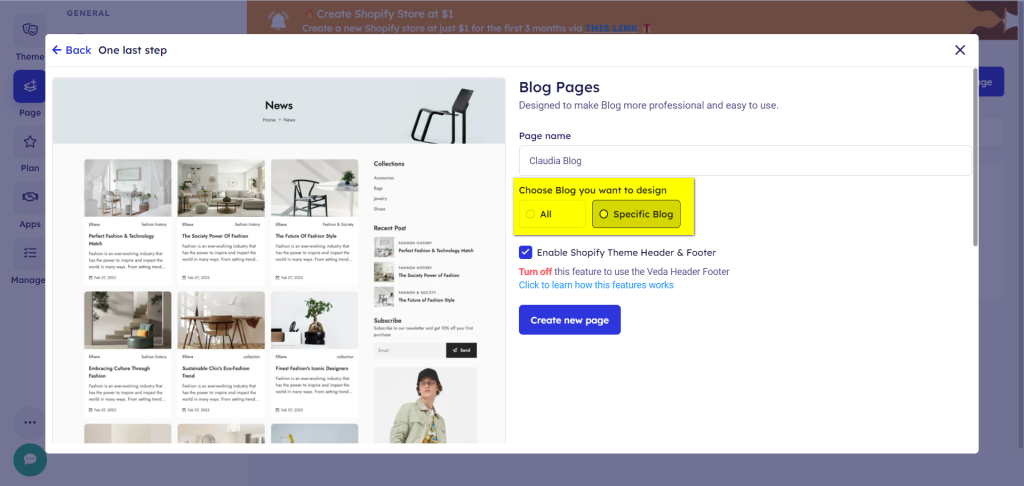Introduction
Shopify blog templates are essential tools for enhancing the effectiveness and appeal of your online store’s blog. In today’s digital marketplace, a well-crafted blog is not just a platform for sharing ideas but a vital component of any successful e-commerce strategy. A Shopify blog template can transform your blog into an engaging, organized, and visually appealing part of your website.
In this post, MyShopKit will explore the key components that make a blog page successful, how to encourage customer interaction, and the importance of structuring your content effectively to capture and retain your audience’s attention.
Understanding the Shopify Blog Page
Introduction to Shopify Blogging
The Shopify Blog Page is a collection of various blog articles that discuss topics related to your products and business. This page serves as a central place where all these articles are gathered, making it easy for visitors to find and read them.
Features of the Shopify Blog Page
When you access the Shopify Blog Page, the most recent article is displayed first. Each article comes with essential details like its title, the date it was written, and the name of the author. This organization helps readers to quickly find the newest and most relevant information.

Role of Blogging in Business Growth
A business blog, like the one you can create with a Shopify blog template, is a crucial marketing tool. It’s not just a collection of articles; it’s a strategy to enhance your business’s online presence. By using a Shopify blog template, your business blog becomes a dynamic part of your marketing efforts, drawing more attention to your business and potentially aiding in its growth.
This Shopify blog template allows you to consistently update your website with fresh content, keeping your audience engaged and informed about your products and business. In short, it’s a valuable asset for any business looking to expand its online visibility and connect with customers.
Enhancing Your Shopify Store with a Blog Page
Boosting SEO with a Shopify Blog
Search Engine Optimization (SEO) is a crucial factor in determining a website’s credibility and visibility. By using a Shopify blog template to create and upload high-quality articles, you establish trust with your customers. This trust, in turn, improves your website’s ranking in search engine results. A higher ranking makes it easier for customers to find your store on Google when they’re looking for products you offer. In essence, a Shopify blog template helps you reach a broader audience organically, which can lead to better conversion rates.

Strengthening Brand Awareness
A well-maintained blog, especially one using a Shopify blog template, can significantly enhance your brand’s visibility. Quality blog content often ranks high in search results and is more likely to be shared by readers. This sharing leads to more organic, word-of-mouth traffic. Unlike other types of media content, which are typically pushed from the business to the customer, a compelling blog post can be easily shared and recommended among users. This sharing creates a positive impression, builds credibility, and enhances the image of your company.
Promoting Products and Services Effectively
Blog posts are an excellent medium for introducing new products and services to your customers. Using a Shopify blog template, you can create content that addresses your customers’ needs and highlights the value of your products. This type of high-quality content is more likely to lead to effective sales conversions. By addressing customer pain points and showcasing how your products or services can solve them, you create a direct path to sales, making your blog an invaluable tool for promotion and customer engagement.
Creating a Shopify Blog Template: A Step-by-Step Guide
Introduction to Veda Landing Page Builder
Veda Landing Page Builder is a Shopify app designed for users without programming knowledge. It offers a simple solution for building professional and stunning website designs. The app features a live drag-and-drop interface, making it easy to create appealing layouts.
Step 1: Installing Veda on Your Shopify Store
First, you need to add the Veda Landing Page Builder app from the Shopify App Store. In your Shopify admin panel, authorize the app by clicking “Install app.”

Step 2: Beginning Your Blog Page Construction
To start building your blog page:
1. Open Veda: In the Shopify admin, navigate to the apps section and click on the Veda icon.

2. Access the blog pages section in the app dashboard > Create a new page.

There are two methods to create a blog page:
– Creating Your Own Template: Select a blank template and start customizing.
– Using Pre-Designed Veda Templates: Veda offers various eye-catching FREE shopify blog templates. Preview these templates and “Install” one to work with.

Before creating the blog page template, choose blog(s) to apply the template:
– “Apply” for all blogs (Overwrite theme template): Use the Veda blog template for all your blogs, replacing the default Shopify template.
– “Specific blogs”: Select specific blogs for applying the new design.

Step 3: Customizing Your Shopify Blog Template
Customize your Shopify blog template by:
1. Click on any available sections to open its settings. Designing each part of the template to align with your brand, products, and services. Edit everything from layout to design and advanced settings.
2. Add new sections

– Note: Replace all images to avoid copyright issues with the template.
Step 4: Saving and Publishing Your Blog Page
After editing, click “Publish” in the top right corner.

By following these steps, even beginners can easily create and customize a blog page using the Veda Landing Page Builder, enhancing their Shopify store’s appeal and functionality.
📚 You may also like: Easy Steps to Build Shopify Landing Page + CRO Examples.
Essentials for a Successful Shopify Blog Page
Encouraging Interaction
One key to a successful blog page, especially when using a Shopify blog template, is to encourage customer interaction. This keeps customers engaged and connected with your store for a longer time. Design your blog page with elements that motivate visitors to take action, such as comment sections, newsletter sign-up forms, or social sharing options. Utilizing the Shopify blog template effectively can help you collect valuable customer emails for further engagement.

Organizing Clear Blog Collections
Your Shopify blog should cover a variety of topics, ranging from product and service information to market research and trending news. To enhance customer experience, it’s crucial to categorize these posts into clear tags like “Product & Service,” “Hot News,” and “Market Research.”

This organization, facilitated by a Shopify blog template, makes it easier for customers to find relevant information and positively impacts their experience on your site.
Using Catchy Images
Images play a vital role in capturing customer attention and stimulating their imagination. To make your blog more engaging, include eye-catching images that follow a consistent color theme. This color theme should reflect your brand’s identity, helping to distinguish your store from competitors and increase brand awareness in the market.
Structuring the Blog Page Effectively
The structure of your blog page is crucial for attracting and retaining readers. A well-arranged content layout can reduce bounce rates and enhance the reading experience. Avoid overcrowding the page with too much content or banners.

Instead, strategically place related posts and newsletter subscription buttons in areas where readers are likely to engage with them, usually at the bottom of the page after they have finished reading. A well-designed Shopify blog template can assist in achieving an optimal structure for your content, making it more appealing and reader-friendly.
Conclusion
In conclusion, a Shopify blog template is more than just a layout; it’s a strategic tool for elevating your brand’s online presence. By focusing on interactive elements, organizing content into clear categories, using catchy images, and structuring your blog page effectively, you can significantly enhance user engagement and brand recognition. Implementing these strategies will not only make your blog visually appealing but also ensure that it serves as a dynamic and valuable asset for your business growth.









